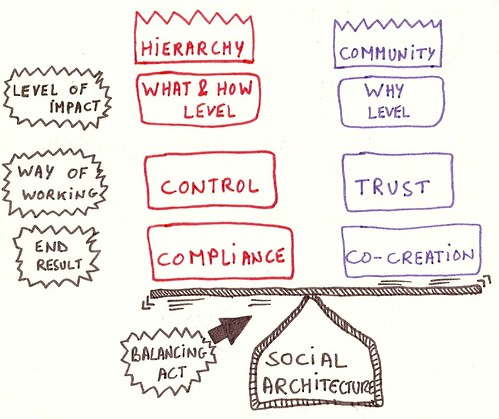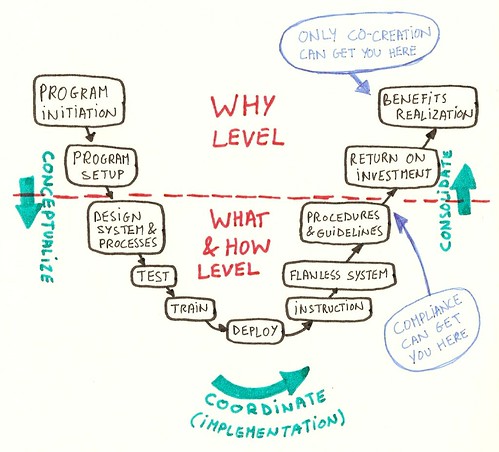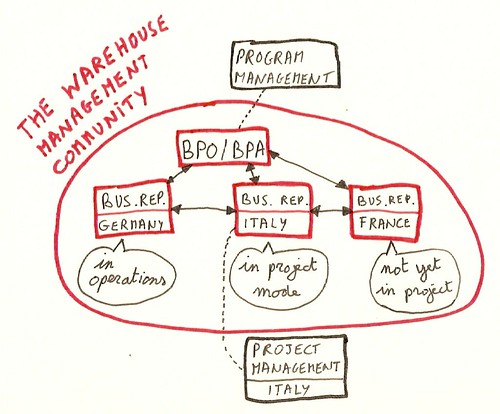When the rubber of program success hits the road, we see that tribal leadership is the mechanism that makes a social architecture tick. And this urges us to strike a balance between compliance and co-creation.
In the first article of this series I explored what successful change programs look like from the strategic point of view. From that perspective, social architecture is the only thing that connects an organizational change program to its goals.
In the second article I zoomed in on what this connection looks like on the tactical level and it turns out to be essentially about connecting all the stakeholders in order for them to co-create the results.
In this article I am exploring the operational point of view: what social architecture comes down to in day-to-day practice.
The Times, They Are a-Changin’
But before we dive into workplace dynamics we need to take into account of the fact that the internet is fundamentally changing the DNA of workplace dynamics.
As we are witnessing the end of the Industrial Revolution, we discover that leadership and workplace dynamics are no longer hierarchical. That game is over.
The way we used to run our companies and projects today was inspired by the logic of a 120 years old Scientific Management. Command-and-control was the slogan that would create economic growth. And it did. Without any doubt, our economy, our society and our well-being would not have progressed to the current levels of prosperity without compliance and obedience.
But the good old economy isn’t what it used to be. It is sputtering and it seems to be more than just an innocent cough. In an earlier article I have argued that the internet has changed the dynamics of our economy. Compliance is no longer the shortest path to productivity.
To visualize how the internet has flipped the (em)power laws of our society, have a look at the below comparison:
A. The power laws of the Industrial Revolution

B. The power laws of the Digital Economy

When the world changes, the rules change. And if you insist on playing today’s games by yesterday’s rules, you’re stuck. The truth is that relationships are no longer hierarchical, they have become tribal.
Tribes
Regular readers of this blog know that I can’t stop talking about Major Jim Gant. He knows what social architecture looks like in practice. His work on TTE – Tactical Tribal Engagement is unprecedented for counterinsurgency tactics in Iraq and Afghanistan. His contention is to work with tribalism, not against it. In his free ebook ‘One Tribe at a Time’ he talks about Influence without authority:
Sitting Bull and I enjoyed each other’s company. Our camaraderie set the tone for our team’s relationship with their rest of the tribe. We laughed and spoke of many things that most US forces are taught as being taboo.
There is nothing (and I emphasize nothing) that can prove yourself and your team to the tribe more than fighting alongside them. That is the ultimate testament of your team as warriors and your commitment to the tribe. It will create the foundation for influence without authority that is the key to success in tribal engagement.
A tribe is the mechanism that makes a social architecture tick. In his 2009 book Tribes: We Need You to Lead Us, Seth Godin notes that a group only needs two things to be a tribe: a shared interest and a way to communicate.
According to Godin the role of a leader is to help increase the effectiveness of the tribe and its members by:
- transforming the shared interest into a passionate goal and a desire for change;
- providing tools to allow members to tighten their communications, and
- leveraging the tribe to allow it to grow and gain members.
Trust
The shift from hierarchical leadership to tribal leadership makes it clear that social architectures don’t need control; they need trust.
Tribal leadership of the Business Process Experts (BPE’s) and Business Process Architects (BPA’s) is necessary here. The example of the Warehouse Management Community I presented in the first article is not a legal structure with binding function descriptions. Instead, look at it as a tribe.
The power of such a tribe lies in two simple things:
- the intensity of their communications (the black arrows), and
- the reinforcement by the program sponsor that legitimizes a safe space for them to form a tribe (the red circle)
Unfortunately we often find that BPE’s and BPA’s lack the maturity to lead their tribe. Maturity in this case is the ability to say “I don’t know and therefore I need the help of my tribe of Business Representatives”
This requires the tribe leader to be vulnerable and mature. The paradox for the tribe leader is the following: the more you are ready to admit that your don’t know and that need help – to the same extent you will be honoring your tribe.
Knowledge that Matters
Question: Where does the knowledge of the tribe reside?
Answer: In the community.
Question: How do you tap into it?
Answer: By honoring / challenging the community: trust them to solve a problem. Praise them for a problem well solved.

The knowledge that is needed to determine whether a problem is bad or a whether a solution will work resides in the community. Not in the head of an individual, but in the relationships. It is the tribe that is being built as a result of the change program that will determine whether a new change or enhancement is relevant. That is: if you are brave enough to trust your tribe with this assignment.
Knowledge is in the co-creation, the problem solving and the sense making process of a tribe – only to the extent that they are trusted by their leader.
Now What?
Question: So should you just lay back, throw everything you know over board and wait until this tribal mumbo-jumbo comes falling out of the sky?
Answer : No. The only thing you should do is stop sprinting, because this isn’t a race. It’s not even a marathon.
This is an expedition where the success demands polyvalence, flexibility, knowledge of details, creative problem solving, trust and – above all – the right balance between hierarchy and tribalism.
The one thing you need to know is that tribalism and hierarchy impact different levels of a change program. In the end, you will be needing both; it’s just a matter of knowing which results you want to achieve. Next, you search for the right balance between control and trust.

If you want people to deliver on the why level of a program (the benefits realization and the return on investment) you need more trust and involvement.
Remember the drawing I introduced in the previous article. I highlighted three C’s that are important for a program to be successful. The point I want to emphasize here is that the knowledge that is required for all of these C’s resides in the tribe.

And here is the trap: the fact that the second C (Coordination) can be done with a rigid compliance regime of command-and-control, leads us to believe that the first C (Conceptialize) and the third C (consolidate) will blend accordingly. Command-and-control only works if you want compliance, until you hit the ceiling of the What & How level. Crossing the border from this level to the Why level (Benefits Realization and ROI) requires involvement of the tribe in the conception upfront.
Benefits realization is the rough spot; the uncharted part of the expedition. Only tribes can slug out the realization of benefits. By now you will understand that a social architecture is not an overnight success story. Rather, it’s a succession of small steps that all point in the same direction: return on relationships.
The good news: As it happens, organizational change programs are the best environment to start-up a tribal mechanism for co-creation.





Pingback: How to Belong to the 30% Successful Projects (Part 2) | Reply-MC()